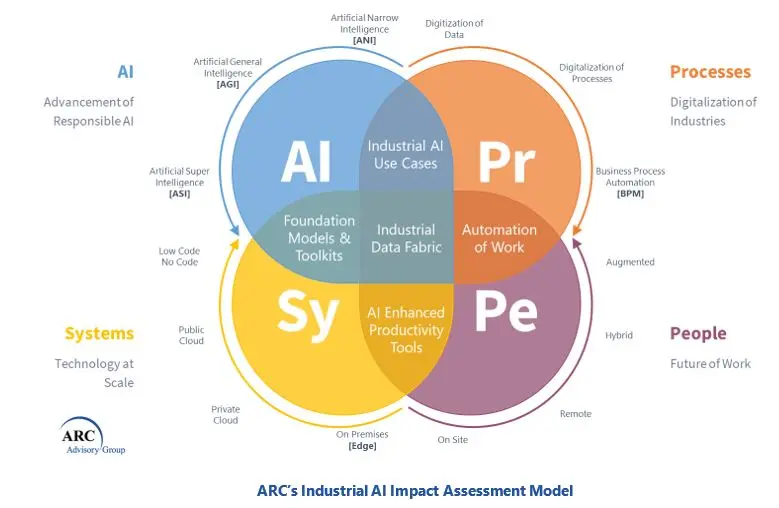

ARC Advisory Group has embarked on a mission to simplify the complex, identify relevant breakthroughs, and cut through the hype surrounding industrial AI. Central to this mission is The Industrial AI (R)Evolution Strategy Report that cuts through the Generative AI hype, dispels myths and summarizes the latest developments and trends in the field. In that Strategy Report we introduce ARC's Industrial AI Impact Assessment Model, a methodology that amalgamates our extensive experience in monitoring technologies and their influence on business processes, human resources, and skills within industrial organizations. This comprehensive model incorporates proven AI techniques that have already demonstrated efficacy in various industrial use cases.
Our approach is not only retrospective but also prospective, considering the latest advancements in Large Language Models and Generative AI. Moreover, we are closely observing the potential of emerging breakthroughs such as Causal AI and Explainable AI, which are yet to permeate mainstream adoption. By seamlessly blending historical insights with forward-looking trends, ARC's Industrial AI Impact Assessment Model offers a robust framework for industrial companies to understand and manage the evolving potential of industrial AI.
To assess the impact of AI holistically, decision-makers in industrial organizations should consider our three-pronged framework:
People: Evaluate how AI will affect your workforce, considering factors like skills gaps, training needs, and job redesign.
Processes: Assess how AI can streamline business processes, improve efficiency, achieve sustainability goals, and deliver stakeholder value.
Technology: Understand the technical implications of implementing AI, including infrastructure needs, data management, sustainability impact, and cybersecurity.
The integration of AI into industrial organizations holds the potential to not only address the growing skills gaps in manufacturing but also to redefine work and the skills required for the future. AI promises to facilitate the delivery of innovative sustainable products, services, and experiences that meet the evolving demands of consumers.
It's important to note that for many industrial organizations already grappling with labor shortages and skills gaps, AI is not intended to replace people but rather to augment human capabilities. Paraphrasing many of ARC's leading customers, "AI won't replace people— but people augmented with AI will replace people without AI." This encapsulates the transformative power of AI. It equips individuals with the tools to perform their roles more effectively and efficiently, driving the industrial organizations of the future.
Simplistically we show in our Industrial Worker graphic, how mainstream adoption and governance of AI results in:
AI Infused Systems Development and Scale Deployment
Intelligent Business Applications and Industrial Automation
Closing Skills Gaps with AI Assisted Work

In our Venn diagram the ARC Industrial AI Impact Assessment Model considers:
The evolution of AI from academia and research into the mainstream systems through scale technologies as we progress from the ANI towards the AGI that we seem to be close to attaining with the latest breakthroughs in generative AI with LLMs, GANS and Transformers, towards the aspirational (and some say 'scary') ASI.
The evolution of software design patterns, and the industrial software landscape as the whole paradigm of user interaction goes through radical redesign whether the underlying software is itself 'intelligent', or just receiving a facelift to make it more accessible. At the core of this revolution in software design we see a necessary foundation of 'Industrial Data Fabric', and advanced tools for securely building or extending Foundation Models.
We've identified 25 Industrial AI use cases that are leveraging various AI techniques and technologies and should be prioritized as these organizations accelerate their digitization of data, digitalization of processes, and use AI to increase Business Process Automation (BPA), on their journey to more sustainable products, processes, and shareholder returns. These are published in a companion ARC Insight.
We also consider how the automation of work, or augmentation of frontline workers, industrial engineers, sales and service technicians, and IT, OT and ET software developers could impact the very nature of their work, and the skills required by industrial organizations for that future. While AI has had some impact over its decades of adoption, this is perhaps where Generative AI will have revolutionary impact with AI 'Copilots', already announced by Google, Microsoft, and Sight Machine.
As we continue to explore the potential of generative AI and other breakthroughs in industrial AI, we'll share more on how to apply ARC's Industrial AI Impact Model.
The future of Industrial AI is promising, with its potential to transform industries and societal structures. By deepening our understanding and effectively applying AI technologies, we can unlock their true potential in the industrial realm.
For more information or to contribute to Industrial AI research, please contact Colin Masson at cmasson@arcweb.com .

